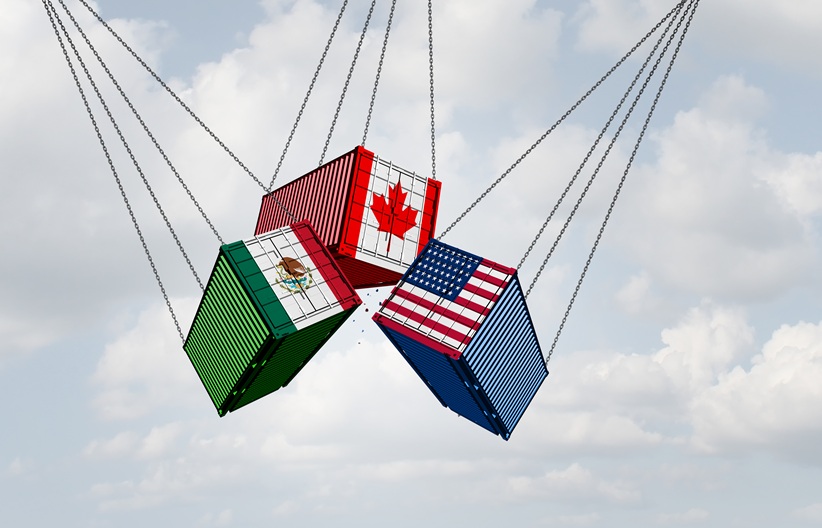
USMCA: A Critical Tariff Shield for Cross-Border Freight
The United States-Mexico-Canada Agreement (USMCA) has emerged this spring as a critical lifeline for transportation companies navigating the world of cross-border operations.
Because compliance with USMCA now means exemptions from tariffs for products entering the U.S. from Canada or Mexico, understanding the agreement has shifted from a regulatory formality to a strategic business imperative for the supply chain, including motor carriers and freight brokers.
The tariff landscape: What’s happening now
The logistics and transportation industries awaited the originally announced April 2 tariffs with bated breath. While the implementation timeline shifted after stock market reactions to tariffs on practically the entire world, one crucial development stands firm: Mexico and Canada weren’t included on the April 2 list and remain unaffected by the April 9 reversals.
What does this mean for cross-border freight? Despite the back-and-forth between the U.S., Canada, and Mexico, and a baseline tariff of 10% for all countries outside of North America and China, companies can still import goods from our northern and southern neighbors without paying these hefty additional costs. The catch? They must comply with USMCA requirements or be subject to a 25% tariff.
What is the USMCA?
The USMCA, signed in 2018 and implemented in mid-2020, replaced the 1993 North American Free Trade Agreement (NAFTA). While NAFTA initially enjoyed bipartisan support, it eventually drew criticism for contributing to manufacturing job migration to Mexico’s lower-cost labor market.
Removing NAFTA was a central campaign promise for Donald Trump in 2016, and ratifying USMCA became a significant achievement for his first presidential administration. Now, the agreement has taken on renewed importance as a shield against the current wave of tariffs.
Key aspects of USMCA include:
- Increased regional content requirements, requiring 75% of a vehicle’s parts to be made in North America to avoid tariffs (up from 62.5% under NAFTA)
- Stronger labor protections, particularly in Mexico
- Greater cross-border market access for American and Canadian dairy farmers
- Enhanced cooperation on digital trade and cybersecurity
- Strengthened intellectual property rights
What makes a product USMCA-compliant?
This is the crucial question for importers—and therefore carriers and brokers—in the coming months.
A product qualifies for USMCA compliance if it meets specific rules of origin, meaning it’s either sourced completely from one of the three countries or has a “minimum percentage of value” added in one of these nations. Importers must carefully analyze all components and materials in their products and verify their origin to determine if requirements are met.
According to S&P Global Market Intelligence, only 37.8% of imports from Canada and 48.9% from Mexico were previously identified as eligible for duty-free status. However, since most imports were tariff-free before recent changes, USMCA-compliant certification wasn’t always necessary, potentially making these percentages somewhat misleading.
Nevertheless, businesses of all sizes have been undertaking the time-consuming but worthwhile process of confirming compliance to avoid the steep 25% tariff on non-USMCA compliant goods.
Implications for carriers and brokers
The impact of USMCA exemptions varies significantly depending on your freight specialization and operational focus:
For agricultural and food product specialists
If your company brokers or hauls agricultural or food products from Mexico or Canada, the duty-free exemption process is relatively straightforward. Verifying that an avocado was grown in Mexico or a dairy product comes from Canada doesn’t require complex supply chain analysis.
For complex manufacturing supply chains
Carriers and brokers working with products that have multi-country supply chains face more significant challenges. Importers who can’t obtain USMCA compliance or who deal with products assembled using components from countries outside North America will face the 25% tariff on non-compliant goods.
This cost increase will likely flow through the entire supply chain, potentially reducing consumer and business demand and leading to fewer loads to haul or broker. Brokers may find it increasingly difficult to charge shippers competitive yet profitable rates, while carriers could face additional pressure from equipment and maintenance cost increases under inflationary conditions or tariffs on auto parts.

The China factor
The prospect of massive tariffs on Chinese imports creates an interesting counterbalance. If these high tariffs on Chinese goods and the end of the de minimis exemption persist, they could accelerate nearshoring to Mexico and domestic production, even accounting for non-USMCA compliance challenges and levies.
Strategic responses for carriers and brokers
Forward-thinking carriers and brokers can use several strategies to help leverage USMCA compliance as a competitive advantage:
Documentation automation
Streamlining paperwork through automation tools such as Transflo Workflow AI can help mitigate delays caused by customs slowdowns and tariff-related bottlenecks. Advanced automation solutions that reduce manual work and simplify audit processes are already helping both carriers and brokers manage a complex freight economy.
Enhanced monitoring capabilities
Given the fluid nature of tariff policies, keeping current on regulatory updates is critical. Fleet managers and brokerage experts can invest in analytics and market intelligence tools that provide up-to-the-minute insights into shifting freight volumes, rate changes, and customs delays.
Strategic capacity management
With volume fluctuations likely, carriers should develop flexible capacity strategies. This might include diversifying equipment types, cross-training drivers for different loads, or exploring asset-sharing partnerships during low-volume periods.
USMCA certification support
Brokers can provide support services or partner with dedicated customs brokerages to help shippers navigate USMCA certification requirements. By positioning themselves as partners in compliance, intermediaries can strengthen customer relationships during uncertain times.
Looking ahead: Navigating tariff turbulence
While the transportation industry faces continued uncertainty in cross-border operations, USMCA compliance provides a valuable pathway for maintaining efficient trade flows. For carriers and brokers, understanding and helping customers navigate these requirements could be a strategic advantage in a complex marketplace.
By leveraging automation solutions, maintaining clear communication with customers and shippers, and developing partnerships in USMCA compliance, carriers and brokers can position themselves to survive the tariff turbulence.
TL;DR
The USMCA has become a critical “tariff shield” for cross-border freight, allowing imports from Canada and Mexico to avoid tariffs if they meet compliance requirements. While Mexico and Canada were excluded from recent tariff waves, USMCA compliance is now essential when possible.
The agreement replaced NAFTA in 2020 with stricter requirements (75% North American content for vehicles vs. 62.5% under NAFTA) and requires products to meet “rules of origin” through sourcing or value-added requirements. Impact varies by industry: agricultural/food products have straightforward compliance, while complex manufacturing supply chains face challenges since only 37.8% of Canadian and 48.9% of Mexican imports were previously duty-free eligible.
Strategic responses include documentation automation, enhanced monitoring, flexible capacity management, and USMCA certification support services. With high tariffs on Chinese goods potentially accelerating nearshoring to Mexico, understanding and navigating USMCA requirements has become a competitive advantage for carriers and brokers in the volatile tariff landscape.



